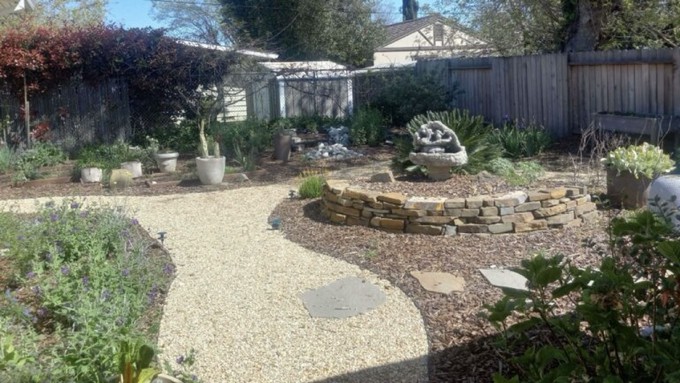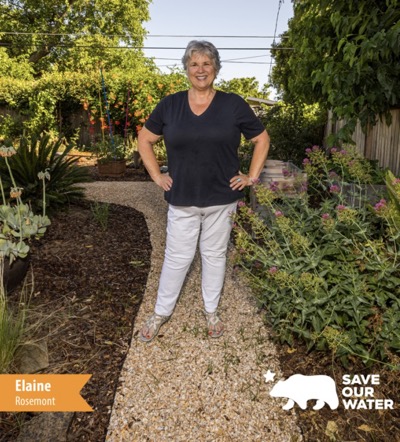
Master gardener uses rebates to create her dream outdoor space

Elaine Fitzgerald replaced her lawn with a peaceful landscape of low-water plants that also attract beneficial insects and birds. Courtesy Elaine Fitzgerald
Elaine Fitzgerald wanted to see more life in her Rosemont backyard. To get that, the lawn had to go.
“I had a lot of lawn, but no life,” she recalls. “It was a dead environment; no insects, no birds, nothing.”
A Sacramento County master gardener, Fitzgerald decided to transform her lifeless lawn into an easy-care garden filled with low-water plants.

“It’s something I wanted to do for a really long time,” she says. “I’ve been an environmentalist since I was a kid. … I wanted to create an environment where wildlife can thrive.”
Fitzgerald has done just that. Her backyard is now filled with bees, butterflies and other beneficial insects. Birds are constant visitors.
“I love the way it’s laid out,” she says. “It’s all curvy; it moves. It’s very peaceful to be out in the middle of it; it’s so full of life. Nowhere can you look and not see insects and birds; it’s phenomenal. I sit out there and watch. It brings me a lot of joy.”
For her efforts, Fitzgerald was honored by the Regional Water Authority as a “Summer Strong Yard” winner. Her garden was featured on local billboards to provide inspiration to other gardeners interested in transitioning to a water-wise landscape.
Fitzgerald got a big boost for her project from her local water provider, California American Water. She took advantage of rebates for River Friendly Landscape conversion.
“The rebates were wonderful,” says Fitzgerald, who completed the project in 2023. “I was stunned. I got $2,300 for my backyard; that was a big part of my budget. It really pushed me over the edge to do it.”
With the help of two friends, Fitzgerald competed the project for about $6,000, she adds. “So, minus the rebate, it was under $4,000 for a whole redesign and brand new landscape.”
Her new backyard is much more inviting to people and wildlife.
“I now have a space with a combination of planting beds, vegetable beds, seating areas, swales and water features for birds and insects,” Fitzgerald says.
Her water use “has gone down tremendously,” she says. “I didn’t know anything about drip irrigation before this project. Now, I do.”
And maintenance? “When I was mowing and blowing my own yard, it would take me most of Saturday every week to do the lawn,” Fitzgerald recalls. “It was so pointless – and I’m not doing it any more.
“Because I am getting older, I wanted a space that would require minimal upkeep and I have achieved that goal,” she adds. “I spend more time enjoying my landscape rather than maintaining it.”
For more information on rebates and other Summer Strong winners, go to: https://bewatersmart.info/
Comments
0 comments have been posted.Sacramento Digs Gardening to your inbox.
Food in My Back Yard Series
April 1: Don't be fooled by these garden myths
March 25: Fertilizer tips: How to 'feed' your vegetables for healthy growth
March 18: Time to give vegetable seedlings some more space
March 11: Ways to win the fight against weeds
March 4: Potatoes from the garden
Feb. 25: Plant a fruit tree now -- for later
Feb. 18: How to squeeze more food into less space
Feb. 11: When to plant? Consider staggering your transplants
Feb. 4: Starting in seed starting
Sites We Like
Garden Checklist for week of March 30
Your garden doesn’t mind April showers. Get busy now to enjoy those future flowers.
* Get ready to swing into action in the vegetable garden. As nights warm up over 50 degrees, start setting out tomato, pepper and eggplant transplants.
* From seed, plant beans, beets, cantaloupes, carrots, corn, cucumbers, melons, pumpkins, radishes and squash. (Soak beet seeds overnight in water for better germination,)
* Plant onion sets.
* In the flower garden, plant seeds for asters, cosmos, celosia, marigolds, salvia, sunflowers and zinnias.
* Transplant petunias, zinnias, geraniums and other summer bloomers.
* Plant perennials and dahlia tubers for summer bloom.
* Transplant lettuce and cabbage seedlings.
* April is the last chance to plant citrus trees such as dwarf orange, lemon and kumquat. These trees also look good in landscaping and provide fresh fruit in winter.
* Smell orange blossoms? Feed citrus trees with a low dose of balanced fertilizer (such as 10-10-10) during bloom to help set fruit. Keep an eye out for ants.
* Apply slow-release fertilizer to the lawn.